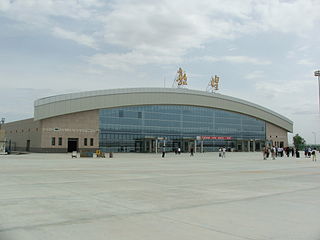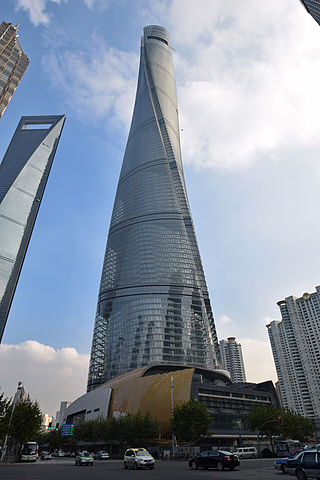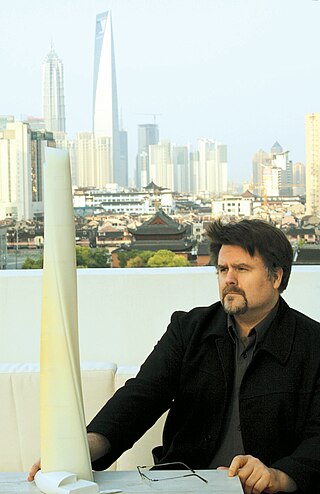Related Research Articles

The People's Liberation Army Naval Medical University (中国人民解放军海军军医大学), also known as the PLA Second Military Medical University (SMMU) (中国人民解放军第二军医大学), is a public university in Shanghai, China. It was founded in September 1949 and named in July 1951. It is a national key university supported by the state Project 211. It is a Chinese state Double First Class University, included in the national Double First Class University Plan. As of 2022, the Second Military Medical University is ranked between top 601-700 among world universities according to the Academic Ranking of World Universities.

Guilin Liangjiang International Airport is the airport serving the city of Guilin in Guangxi Zhuang Autonomous Region, China. It is located in Liangjiang, about 28 km (17 mi) southwest of the city center.

Dunhuang Mogao International Airport is an airport serving the city of Dunhuang in Gansu Province, China. The airport was formerly known as Dunhuang Airport until June 2020.

Guiyang Longdongbao International Airport is an airport serving Guiyang, the capital of Guizhou Province.

Jinan Yaoqiang International Airport is the airport serving Jinan, the capital of Shandong Province, China. The airport is located approximately 33 kilometres (21 mi) northeast of the city center and immediately to the north of the Yaoqiang Subdistrict (遥墙街道) after which the airport is named. By road, the airport is connected to the Jinan Ring (济南绕城高速公路), Beijing–Shanghai, and Qingdao–Yinchuan Expressways.

Shanghai Tower is a 128-story, 632-meter-tall (2,073 ft) megatall skyscraper in Lujiazui, Pudong, Shanghai. It is the tallest building in China and the world's third-tallest building by height to architectural top. It is the tallest and largest LEED Platinum certified building in the world since 2015. It shares the record of having the world's highest observation deck within a building or structure at 562 m. It had the world's second-fastest elevators at a top speed of 20.5 meters per second until 2017, when it was surpassed by the Guangzhou CTF Finance Center, with its top speed of 21 meters per second. Designed by international design firm Gensler and owned by the Shanghai Municipal Government, it is the tallest of the world's first triple-adjacent supertall buildings in Pudong, the other two being the Jin Mao Tower and the Shanghai World Financial Center. Its tiered construction, designed for high energy efficiency, provides nine separate zones divided between office, retail and leisure use.
The Urban Planning Society of China (UPSC) (中国城市规划学会), voluntarily incorporated by urban planners across the People's Republic of China in 1956, is the only legally registered academic organization at state level.

Jay Marshall Strabala is an American architect who has participated in the design of skyscrapers and other buildings. In 2010, Strabala founded 2DEFINE Architecture, an architectural firm, with three Chinese partners, though the partnership later soured. Before that, he had been employed by Skidmore, Owings and Merrill (SOM) and Gensler.

The Ping An Finance Center is a 115-storey, 599.1 m (1,966 ft) supertall skyscraper in Shenzhen, Guangdong, China. The building was commissioned by Ping An Insurance and designed by the American architectural firm Kohn Pedersen Fox Associates. It was completed in 2017, and is the tallest building in Shenzhen, the 2nd tallest building in China and the 5th tallest building in the world. It also broke the record of having the highest observation deck in a building at 562 m (1,844 ft). It is the second largest skyscraper in the world by floor area after Azabudai Hills Main Tower in Tokyo, Japan.

Wuhan Greenland Center is a 476 metres (1,562 ft) tall skyscraper in Wuhan, China. The tower was originally planned to be 636 metres (2,087 ft), but it was redesigned mid-construction due to airspace regulations so its height does not exceed 500 metres (1,640 ft) above ground level.

Chengdu Tianfu International Airport is a major air hub of Western China and one of the two international airports serving Chengdu, the capital of China's Sichuan province, the other one being Chengdu Shuangliu International Airport (CTU).

Yinchuan–Xi'an high-speed railway, is a dual-track, electrified, high-speed rail line in Northwest China between Yinchuan and Xi'an. The line is the first railway to connect Qingyang to the Chinese railway network, and also the first railway to connect Ningxia and Yinchuan to the high-speed railway network.

The Shanghai Financial Court is the first specialised financial court to be established the People's Republic of China. It was established in August 2018 to provide specialised handling of finance related cases.
Rong Baisheng was a Chinese architect and civil engineer. A pioneer in skyscraper design and construction in China, he was elected an academician of the Chinese Academy of Engineering in 1995. His works include the Guangdong International Building, which was China's tallest building when completed in 1990, and the Shenzhen Shangri-La Hotel (1981).
Zhuang Weimin is a Chinese architect who is a professor and dean of the School of Architecture, Tsinghua University. He is a member of the International Union of Architects (UIA), China Green Building Association (CGBA), APEC Architect Project Monitoring Committee, Architectural Society of China (ASC), and UIA International Professional Practice Commission.

China National Highway 341 will run from Jiaonan in Shandong to Haiyan in Qinghai. It is one of the new trunk highways proposed in the China National Highway Network Planning.

Honglou Times Square is a 313 metres (1,026.9 ft) tall skyscraper in Lanzhou, Gansu, China. Construction started in 2012 and was completed in 2018. It is the tallest building in Gansu.
The Yichang–Xingshan high-speed railway, also referred to in Chinese under the acronym Yichang-Zhengwan high-speed railway connection line, is a high-speed railway under construction between Yichang on the Wuhan–Yichang railway and Xingshan on the Zhengzhou–Wanzhou high-speed railway in Hubei province, China. It will form part of the Shanghai–Chongqing–Chengdu high-speed railway. The total length of the line is 109.38 km (67.97 mi), and there are 3 stations on the whole line. It is a line connecting the Wuhan–Yichang railway and the Zhengzhou–Wanzhou high-speed railway. The line will run from Yichang East station via thee Changgangling area and Xiabaoping station to Xingshan station. In addition, this line is also planned to be connected with Yichang North railway station and the Wuhan–Yichang high speed railway, also currently under construction. The estimated total investment of the project is 18.15 billion yuan, the construction period is 5.5 years, the design speed is 350 km/h (220 mph), and 94.37% of the main line will run on bridge or through tunnel. It is expected to be officially completed and opened to traffic in 2024. After the completion of the line, combined with the Zhengzhou-Wanzhou HSR to form a new east–west high-speed railway route in the Sichuan-Chongqing area, the Wuhan–Chongqing route will be shortened from the current fastest service of 5 hours and 54 minutes to about 3 hours, and Wuhan–Chengdu services will take only 5 hours. At the same time, journeys between Yichang and Beijing will be shortened from the current 8 hours to about 4.5 hours.
References
- 1 2 3 4 "Jun Xia". Council on Tall Buildings and Urban Habitat . Archived from the original on 2019-01-14. Retrieved 2018-12-30.
- 1 2 "Brave Thinkers 2012: Jun Xia". The Atlantic . November 2012. Retrieved 2018-12-30.
- ↑ S&P Global Market Intelligence. "Jun Xia Executive Profile & Biography". Bloomberg L.P. Retrieved 2019-01-01.
- ↑ Russell Flannery (August 7, 2013). "'There Is Never Going To Be A Building Like This In The U.S.'". Forbes . Retrieved 2018-10-09.
- ↑ Ben Ikenson (June 6, 2013). "What's Inside Gensler's Secret Sauce?". Metropolis . Retrieved 2018-10-09.
- ↑ Julie Makinen (June 25, 2015). "U.S. design firm puts its stamp on Shanghai skyline". Los Angeles Times . Retrieved 2018-12-29.
- ↑ "夏军 中国第一高楼的背后". 安邸中国新节奏. April 21, 2015.
- ↑ "夏军 不求最高,只求最好". Gensler亚洲区设计总监、DAO陆道设计独立董事夏军. Jan 26, 2015.